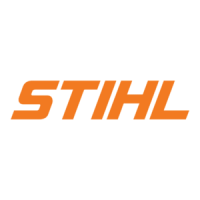
Do you have a question about the Stihl HT70 and is the answer not in the manual?
| Engine Type | 2-stroke |
|---|---|
| Power Output | 0.95 kW |
| Bar Length | 25 cm |
| Sound power level | 104 dB(A) |
| Total length | 270 cm |
| Guide Bar Length | 25 cm |
| Engine Displacement | 31.4 cc |
Explains symbols used in the manual for clarity.
Describes how text elements indicate procedures or refer to illustrations.
Notes how components not installed in all models are marked with an asterisk (*).
Explains STIHL's philosophy of continuous product improvement.
Details physical, mental, and condition requirements for safe operation.
Specifies protective clothing and footwear for safe operation.
Covers safe handling and transport of the pole pruner.
Provides instructions and warnings for safely refueling the pole pruner.
Lists essential preparation steps before operating the pole pruner.
Details proper body posture and hand placement for control.
Describes how to make a relieving cut to prevent kickback or bark tearing.
Explains how to cut thick branches to prevent splitting.
Describes pruning branches that overhang obstacles.
Explains how to use the pole pruner from an elevated platform.
Details the use and adjustment of an optional angled cutting attachment.
Instructions on how to properly tension the saw chain.
Explains how to check if the saw chain tension is correct.
Details how to adjust the throttle cable for proper operation.
Advises on mixing and storing fuel for optimal performance and safety.
Provides detailed instructions and safety warnings for refueling.
Guides on how to properly fill the chain oil tank.
Explains how to verify the chain is receiving adequate oil lubrication.
Explains how to properly fit and adjust the shoulder strap.
Guides on fitting the full harness for secure operation.
Identifies and explains the function of various controls on the unit.
Details the step-by-step procedure for starting the engine safely.
Advises on operation during the initial period to ensure proper engine seating.
Guides on checking chain tension and other operational checks.
Details procedures to follow after completing work, including chain slackening.
Steps for cleaning the air filter to maintain engine power.
Explains how engine parameters control exhaust emissions.
Explains how to adjust the carburetor for optimal performance.
Details how to check and maintain the spark arresting screen.
Explains how to inspect and diagnose issues with the spark plug.
Guides on how to remove the starter cover for access.
Details the process for safely removing the rope rotor.
Provides steps for replacing the starter rope and grip.
Explains the types of replacement springs available.
Details how to install the rope rotor onto the starter post.
Explains how to tension the rewind spring correctly.
Guides on unpacking and handling the new spring assembly.
Details how to correctly fit and secure the starter cover.
Provides instructions for long-term storage of the machine.
Guides on inspecting the chain sprocket for wear.
Specific instructions for replacing the chain sprocket on the HT 70 model.
Notes that HT 75 sprocket replacement must be done by an authorized dealer.
Explains the benefits of a sharp chain and the risks of a dull one.
Provides instructions on how to file the chain cutters correctly.
Explains how to set the depth gauge for optimal chip removal.
Details how to adjust depth gauges after sharpening.
Instructions for cleaning and lubricating the chain after sharpening.
Steps for preparing the machine for extended storage.
Lists chain specifications and part numbers for re-ordering.
Explains the owner's responsibilities and rights regarding the warranty.
Outlines the duration and scope of the manufacturer's warranty.
Details the owner's responsibility for maintenance and proper use.
States STIHL's warranty regarding compliance with regulations and freedom from defects.
Specifies when the warranty period begins and what it covers.
Explains the process for diagnosing issues and how warranty work is handled.
Relates maintenance to warranty and lists warranty limitations.
